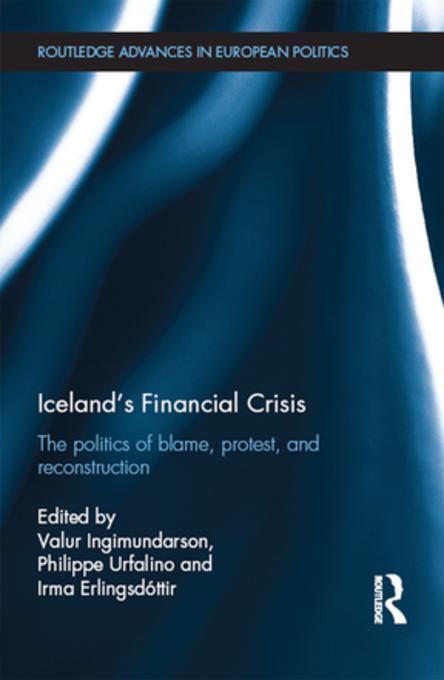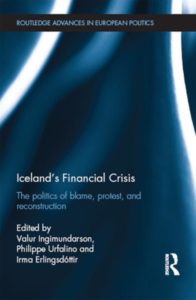
Iceland’s Financial Crisis: The Politics of Blame, Protest, and Reconstruction by Valur Ingimundarson, Philippe Urfalino, Irma Erlingsdóttir

At the time of this writing in September-October 2017, a full decade has transpired since the onset of the Great Recession, which in hindsight would signal the precipice of the 2008 financial crisis. Most of the involved national economies are widely considered to have “recovered” in the sense of returning to macroeconomic growth (Greece is a notable exception). Nevertheless, symptoms of economic crisis, social dislocation, and political instability are still pronounced throughout Europe.
Iceland’s Financial Crisis: The Politics of Blame, Protest, and Reconstruction offers a fresh, in-depth contribution to scholarly debate around multiple dimensions of the Iceland’s experience of the 2008 financial crisis. Despite owning the distinction of being the first national economy to experience the full brunt of the financial crisis in 2008, and the first to “recover” from it, Iceland is no exception to widespread patterns of ongoing consequences.
The volume proceeds in three major parts. Part I, “The road to economic disaster,” which is also the shortest, examines the production of the financial collapse. Part II, “The political and societal responses to the crisis” addresses popular and state responses to the collapse. Part III, “The politics of Iceland’s constitutional reform” explores the demand for a new constitution in the wake of the financial collapse and the government-endorsed, partially-crowdsourced constitutional project.
Part I begins with Gylfi Zoega’s chapter, which takes a macroeconomic approach to explaining the collapse, broadly situating it in a comparative historical trajectory of late-twentieth century cycles of capital inflow and flight. Gudrun Johnsen’s contribution shifts the focus to the specific practices of bank managers. Finally, in this section, Stefán Ólafsson applies a Minskyian analysis to the Icelandic episode, demonstrating that contrary to the classical economic assumption of a tendency todard equilibrium, capitalism is instead prone to instability due to the extension and retreat of confidence. Although the approaches and theoretical frameworks vary, the chapters in Part I together point to ambivalence over whether the Icelanic financial collapse was ultimately a structural or an Icelandic probem. Relatedly, the authors also tack back and forth on the issue of whether Iceland’s experience was typical or unique. On the one hand, Zoega notes that “history repeated itself” and and Ólafsson argues that it was “for the most part a typical financial bubble” (22, 57). On the other, both authors also argue that the Icelandic case was unique because of its scale. In proportion to the scale of the national economy, it ranks among the largest in history. Yet among economies affected by the crisis, the Icelandic banks’ losses were merely a drop in the bucket. In contrast, Johnsen contends that “it did not take an international financial crisis to bring down the Icelandic banks” (51). As the mini-crisis of 2006 indicated, the bankers’ practices rendered the banks weak enough that they were unsustainable regardless of the international market context.
Part II shifts gears to examine responses to the crisis. Jón Gunnar Bernberg and Anna Sofía Víkingsdóttir’s chapter considers the question of why and how the collapse became a political opportunity for a large-scale protest movement to emerge. Similar to the first part of the volume, the chapters in Part II also reveal ambivalence. Next, Helga Kristín Hallgrímsdóttir and Emmauel Brunet-Jailly investigate the contentious episodes that led to the repudiation of sovereign responsibility for the failed banks’ debts. Vilhjálmur Árnason’s chapter discusses the Special Investigation Commission and subsequent democratic experiments, finding that a series of institutional and democratic failures contributed to the production of crisis itself, and that post-crisis “democratic experiments” cannot address the pre-crisis weaknesses. In Chapter 7, Valur Ingimardson compares post-crisis political activities to transitional justice efforts typically associated with regime change: truth and reconciliation, assigning blame, and constructing collective memory. Finally, Stefán Ólafsson concludes the section by exploring economic policy responses. In Iceland, “strategies of redistribution” uniquely resulted in decreased economic inequality. Among these chapters, there is an overarching, unresolved question about whether the radical potential of contentious and non-contentious political responses was fleeting or whether deeper changes are underway as a result of these efforts.
Part III explores the process of constitutional renewal. As Bernberg and Víkingsdóttir note in Part II, a new constitution emerged as one of protesters’ central demands in 2008. Although the subject matter is closely related to that of Part II, Part III delves more deeply into a moment of post-collapse politics that has garnered considerable attention within democratic theory and among social movement participants in a variety of countries. Jon Elster opens Part III with a comparative appraisal of the constitutional process. He analyses the process in terms of the flow of constitutional activity, which varied between bottom-up, top-down, and consultative moments. In Chapter 10, Thorvaldur Gylfason, an economist who served on the Constitutional Council, both acknowledges that the process was flawed and also rebukes the government’s decision to effectively ignore the outcome of the process, particularly the 2012 referendum. Salvör Nordal, a philosopher and also a member of the Council, focuses on the conflicts between political elites, the Council, and civil society, arguing that haphazard implementation of the process may have undermined an otherwise worthy effort to extend and shore up the democratic process. In Chapter 12, Pasquale Pasquino writes admiringly of Nordal’s leadership of the Council, noting that she effectively managed tensions between the Council and parliament, despite casting the project as a whole as a failure. In Chapter 13, Björg Thorarensen analyzes the process through the lens of constitutional law, acknowledging its “noble aims (249). She also points to the contradictions that emerged during the process, such as the question of whether the Council could circumvent the requirements for change as set out in the existing constitution (249). The final chapter, by Jón Ólafsson, concludes the volume on a note of failure. In contrast to Pasquino, he argues that distrust between the Council and political elites intensified during the process. Ultimately, he argues that the Council’s “decision to write a new constitution rather than revise the old one” set the process down a path to failure (253).
Ambivalences surface once again in Part III. The contributors represent a range of positions in the debate over whether the constitutional process has been decisively put to rest and whether it would address the democratic weaknesses that contributed to the crash in the first place. Not only do the contributors to this section disagree as to whether the project was a failure, they also represent divergent perspectives on the question of whether to emphasize the process or outcomes, and the political implications of the chosen approach to analysis.
Taken together, the contributions are united by the theme of ambivalence more than any of the titular themes of blame, protest, and reconstruction. To be sure, such ambivalence can be theoretically productive. The ambivalences within and among the contributions invite challenges to at least three sets of conventional binaries: structure versus agency; success versus failure; and populism versus technocracy. In turn, the tensions between these categories provoke a number of empirical and normative questions. What is the relationship between structural change in the global economy (e.g. financialization) and how these changes were experienced in the Icelandic context? On what grounds can responses to the crash be read as social movement successes or failures, and are these the most effective categories for assessing social mobilization and state responses? To what extent can (and should) representative democracy weather a profusion of both elitist, technocratic and “populist” impulses? These questions are by no means applicable to only Iceland.
The volume also runs up against a few limitations. Although the work benefits from more historical perspective, it is also clear that the political, social, and economic consequences of the collapse are still shaking out, rendering claims about the outcomes of any of the processes involved at best provisional and at other times tenuous. While this situation certainly poses a challenge, it should not detract from the value of the work. Instead, it should highlight the extent to which scholarly production is part of crisis responses.
Indeed, recent political developments in Iceland suggest that despite several years of macroeconomic recovery, many questions elicited by the financial collapse remain unsettled. The last eighteen months alone reveal the depth and extent of the instability. In 2016, the Panama Papers destabilized Iceland’s government more visibly than any other. Not only was the Prime Minister forced to resign, but the revelations also helped scuttle then-President Ólafur Ragnar Grímsson’s bid for a fifth term in an office that he had single-handedly politicized far beyond its historical scope. As the editors note in their introduction, rapid contentious mobilization in response to the Panama Papers reflects ongoing political unrest connected to the financial crisis.
Yet, as they also note, the popular response in 2016 was deeply ambivalent. On the one hand, support for Gunnlaugsson’s Progressive Party collapsed. Overall support for established parties decreased, while a new party gained representation. At the same time, not all of the public officials who were implicated left office. In fact, after nearly three months of wrangling among the represented parties, not only did the Independence Party form government, but Bjarni Benediktsson, one of those implicated, became Prime Minister. Benediktsson was only able to form the thinnest of ruling coalitions with the new party Vidreisn (“Reform,” itself a split from the Independence Party) and Björt Framtid (Bright Future, an iteration of its contentious predecessor, the Best Party). But that government has also turned out to be short-lived. A new scandal, this time, the revelation that Benediktsson’s father had endorsed a convicted paedophile’s petition for “restoration of honor” inspired Bright Future to leave the coalition. New elections are scheduled for October 28, 2017, making the outgoing government the shortest-lived in the history of the Icelandic Republic.
These developments point to perhaps the biggest conceptual question and puzzle that goes unanswered in the volume. What do recovery and reconstruction mean? How can several years of robust macroeconomic growth be squared with the profound instability Iceland’s political system continues to experience? Many of these developments post-date publication of the volume. However, since the return of the establishment to power in 2013, periods of politics-as-usual have been fleeting and subject to frequent contentious interruptions. Thus, nearly a decade on, blame, protest, and reconstruction indeed constitute a set of themes that warrant further exploration.
While book-length analyses of the Icelandic financial crisis began emerging within months of the collapse, this latest contribution to the canon highlights the benefit that historical distance offers both scholars and social and political agents. This volume will be useful for anyone interested in delving further into the case of the financial crisis in Iceland. Its range of contributions provide interdisciplinary depth, inviting readers from various disciplines to consider the crisis from angles that might extend beyond familiar terrain. On the whole, Iceland’s Financial Crisis provides an in-depth, insightful debate about the politics of the 2008 collapse that lays the groundwork for further conversation around the big questions about relationships among democracy, protest, finance, and capitalism that converge in this case.
Reviewed by Alyssa Maraj Grahame, Bowdoin College
Iceland’s Financial Crisis: The Politics of Blame, Protest, and Reconstruction
Edited by Valur Ingimundarson, Philippe Urfalino, and Irma Erlingsdóttir
Publisher: Routledge
Hardcover / 278 pages / 2016
ISBN: 9781138669741
To read more book reviews, please click here.
Published on April 17, 2018.




